Website speed is a crucial factor for both SEO rankings and user experience. A slow-loading site can frustrate visitors, increase bounce rates, and negatively impact conversions. Google also considers page speed when ranking websites, making it essential for online success.
Why Website Speed Matters
When users land on a website, they expect fast load times. Research shows that if a site takes more than 3 seconds to load, 40% of visitors may leave. Moreover, slow websites often suffer from lower engagement and reduced search engine visibility. For example, platforms like High Roller prioritize performance to ensure a smooth and enjoyable user experience.
Here’s how you can optimize website speed for better SEO and user satisfaction.
1. Optimize Images for Faster Load Times
High-resolution images can significantly slow down a website. Consider using:
- Compressed images: Use tools like TinyPNG or ShortPixel to reduce image size.
- Next-gen formats: Convert images to WebP or AVIF for better compression.
- Lazy loading: Load images only when they appear on the user’s screen.
2. Minimize HTTP Requests
Each file (CSS, JavaScript, images) requires an HTTP request, and too many requests can slow down your site. Reduce them by:
- Combining CSS and JavaScript files.
- Using CSS instead of images when possible.
- Enabling browser caching for repeated visits.
3. Leverage Browser Caching
Caching stores parts of your website in a visitor’s browser, reducing load times on return visits. Configure caching with:
- WordPress plugins like WP Rocket or W3 Total Cache.
- Server-side caching via Nginx or Apache configurations.
4. Use a Content Delivery Network (CDN)
A CDN distributes your website’s files across multiple global servers, allowing users to load content from the nearest location. This improves speed, especially for international audiences. Popular CDNs include:
- Cloudflare
- StackPath
- KeyCDN
5. Enable Gzip Compression
Gzip compresses your website’s files before they are sent to the browser, reducing file size by up to 70%. You can enable Gzip through:
- .htaccess file for Apache servers.
- Nginx configuration for Nginx servers.
- WordPress caching plugins with built-in compression features.
6. Reduce Server Response Time
Slow server response can delay your website’s loading time. Improve this by:
- Choosing a high-performance hosting provider.
- Using LiteSpeed or Nginx instead of Apache for faster processing.
- Optimizing your database queries to reduce server load.
7. Remove Unnecessary Plugins and Scripts
Excess plugins and third-party scripts can add weight to your site. Optimize performance by:
- Deactivating unused plugins and replacing heavy ones with lightweight alternatives.
- Loading JavaScript asynchronously to prevent it from blocking page rendering.
- Deferring non-critical CSS and JavaScript to prioritize content loading.
8. Monitor and Test Website Speed
Regularly test your website’s speed using tools like:
- Google PageSpeed Insights (Test here)
- GTmetrix
- Pingdom Website Speed Test
These tools provide insights into load times and recommendations for improvements.
Conclusion
Optimizing website speed is essential for both SEO rankings and user experience. By implementing these strategies—image compression, caching, reducing HTTP requests, and using a CDN—you can create a faster, more efficient website that retains visitors and performs better in search engines.
For further reading on website performance optimization, check out this detailed guide on web performance best practices by Google.
